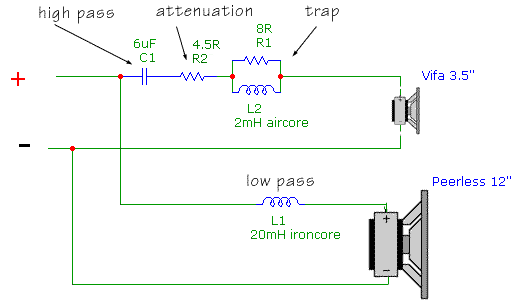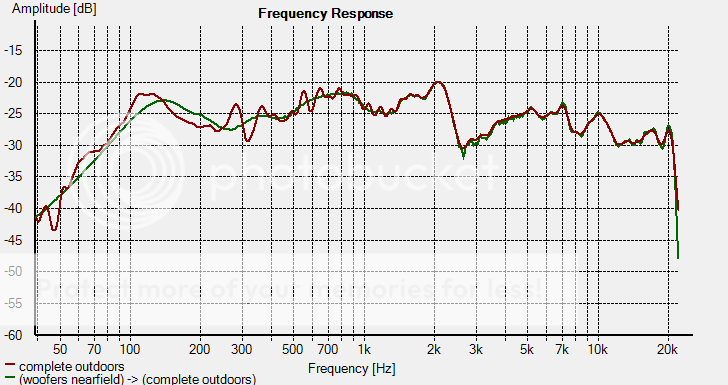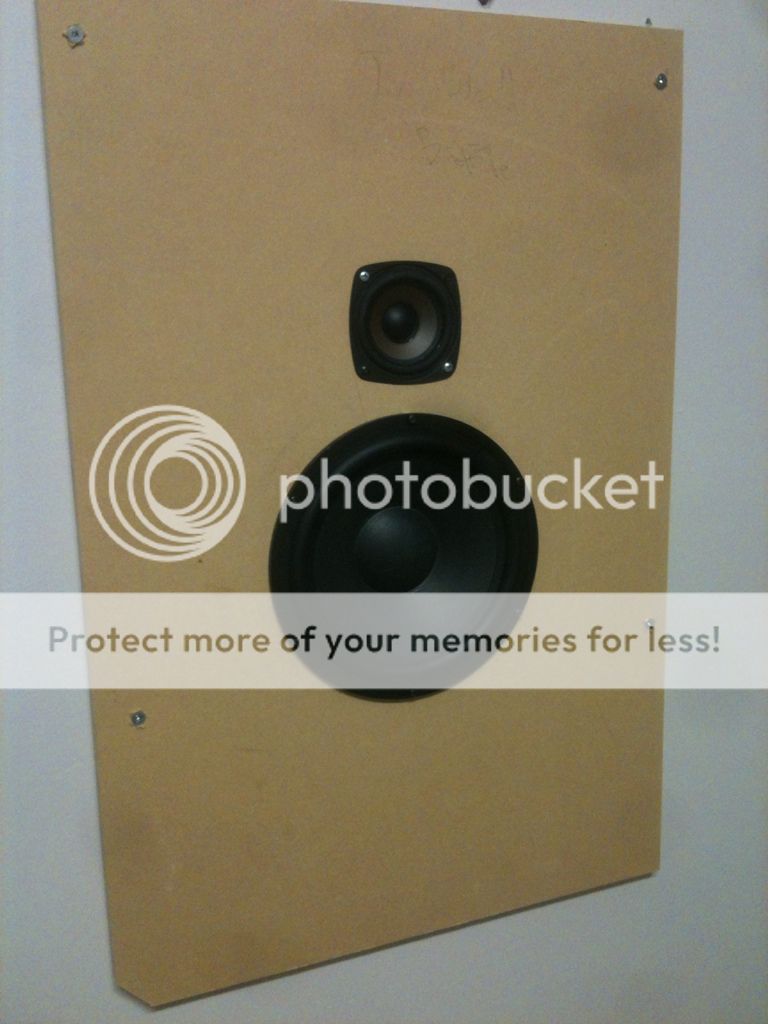I love the idea of FAST. I know there's the Tysen thread, but I've wanted to start a thread like this for a while and a recent comment from Mark Fenlon has prompted me to start it because I can't seem to say what I want to say over in his play ground.
Well, of course it's not about the challenge. That's just silly, but I don't think Mark meant that literally. What I want in a FAST woofer is some with a lot of Vd. So xmax and Sd are most important.
Usually that means big heavy woofers that take gobs of power to push. I'm not concerned with break up as long as it's above say 500 to 750hz. The reason is I believe in using active cross overs for FAST and about 24db/oct does it.
So, what woofers make the best FASTs ?
Does high frequency extention matter to you for low order cross overs or not?
Woof No.6 (EL-166) showed what could be done (near flat/linear response) for modest money once a bit of elbow grease design effort was put in. Ask yourself this question: Why is it that so many woofs have got large peaked outputs, yet sell so well? Surely a crossover design challenge, but why do so many users put themselves through such challenges, maybe because it is a test of their skill to tame an errant driver. Or is it simply that they little alternative product choice?
Well, of course it's not about the challenge. That's just silly, but I don't think Mark meant that literally. What I want in a FAST woofer is some with a lot of Vd. So xmax and Sd are most important.
Usually that means big heavy woofers that take gobs of power to push. I'm not concerned with break up as long as it's above say 500 to 750hz. The reason is I believe in using active cross overs for FAST and about 24db/oct does it.
So, what woofers make the best FASTs ?
Does high frequency extention matter to you for low order cross overs or not?
Here is a list of woofers I would like to try in a FAST
SB Acoustics SB34NRX75-6
SB Acoustics SB29SWNRX-S75-6
Dayton RS270-8
Peerless 830669 for a budget choice
Exodus Anarchy for a compact choice
Seas L26
Some of these will reach down around 20hz and still work with pretty low order cross overs.
SB Acoustics SB34NRX75-6
SB Acoustics SB29SWNRX-S75-6
Dayton RS270-8
Peerless 830669 for a budget choice
Exodus Anarchy for a compact choice
Seas L26
Some of these will reach down around 20hz and still work with pretty low order cross overs.
Can someone please define FAST? Thanks
It stands both for "Full Range and Sub Technology" or for "Fullrange Assisted", if I am not mistaken.
The science and art of marrying a fullrange driver that takes care of most of the audio frequency range with a woofer, crossed low.
Last edited:
Thus the necessity of evaluating both drivers that make a Fast design.
Usually little FR are in the low sensitivity range, and that might go well
with the low efficiency below 100 Hz expressed by most budget woofers, as
the passive crossover might conjugate curves'n'slopes to the best ( for that project).
But also the low ( relatively to woofer+tweeter applications) crossover point
suggests that the FR is called to work from 3-500 Hz and up, so it has to do a double job, plus the distortion rise which is much more audible than that produced by the woofer ( which, I read, can reach 10% and still be 'forgiven'),
so power factor is another thing .
Basing the project on a powerful woofer means nothing; looking for a powerful FR has some issues, as 3" is already 'big' for correct HF dispersion.
Usually little FR are in the low sensitivity range, and that might go well
with the low efficiency below 100 Hz expressed by most budget woofers, as
the passive crossover might conjugate curves'n'slopes to the best ( for that project).
But also the low ( relatively to woofer+tweeter applications) crossover point
suggests that the FR is called to work from 3-500 Hz and up, so it has to do a double job, plus the distortion rise which is much more audible than that produced by the woofer ( which, I read, can reach 10% and still be 'forgiven'),
so power factor is another thing .
Basing the project on a powerful woofer means nothing; looking for a powerful FR has some issues, as 3" is already 'big' for correct HF dispersion.
There is the Manzanita OB design that uses the Peerless 830669 12 inch woofer (89 db) and a Vifa tc9fd 3.5 inch full range. That may be a good starting point for cross over design. The latest version of the design is on post #455 of this thread: http://www.diyaudio.com/forums/multi-way/110583-fast-fun-inexpensive-ob-project-46.html#post2752617
I know you are looking for a FAST design but this seems to have shared requirements. The crossover from the thread is below. FWIW, I think that an active crossover and bi-amp to avoid the rather bulky and expensive power robbing speaker level crossovers.

I know you are looking for a FAST design but this seems to have shared requirements. The crossover from the thread is below. FWIW, I think that an active crossover and bi-amp to avoid the rather bulky and expensive power robbing speaker level crossovers.

Last edited:
OB has another design approach, as explained by Pano in the starting posts
of that thread.
Also, what does 'power robbing' mean ?
Did you know that attaching another amp to the mains causes some 'power suction' ? 😛
of that thread.
Also, what does 'power robbing' mean ?
Did you know that attaching another amp to the mains causes some 'power suction' ? 😛
Not sure what you mean by power suction? Sag in line voltage when amp hits deep bass peaks?
Power robbing refers to how the crossover resistively burns of amplifier power - that is the function of those big power resistors in the crossover. They can get hot. Rather than amplify unneeded audio power just to throw it away in the power resistor, shape it first with active crossover and send to two separate amps for more efficiency. Cost is the other big reason as the 20 mH coil is close to $40 ea. By the time you add up all the costs for the crossovers, an active crossover and second T amp can be had for about same price with the advantage of being adjustable in crossover point. If you go with DSP, the slope can be selected too.
Power robbing refers to how the crossover resistively burns of amplifier power - that is the function of those big power resistors in the crossover. They can get hot. Rather than amplify unneeded audio power just to throw it away in the power resistor, shape it first with active crossover and send to two separate amps for more efficiency. Cost is the other big reason as the 20 mH coil is close to $40 ea. By the time you add up all the costs for the crossovers, an active crossover and second T amp can be had for about same price with the advantage of being adjustable in crossover point. If you go with DSP, the slope can be selected too.
Last edited:
power loss is strictly correct, but a misleading reason to advocate active as a cure-all. Ive never got a 5W W/W warm let alone hot at domestic volumes, and id thank that fuse action if my OP devices ever let go. If loss is a third, it matters a great deal what the input power is before the loss can be viewed as significant. Its only voltage thats lost anyway.
power loss is strictly correct, but a misleading reason to advocate active as a cure-all.
Absolutely. You can boost the bass (active) or cut the treble (passive), but when you run out of excursion on the bass, you run out of SPL. It will happen at the same power level either way. I use active because it is sooo much easier to implement and has other advantages.
Bob
I know you are looking for a FAST design
I'm not looking for a specific FAST design. I just notice a lot of threads saying, what woofer, or what driver, or where to cross over, or what type of cross over. I wanted to discuss woofers and cross overs generically.
For me, I once did a FAST using a pair of Silver Flute W17 because I had space restrictions. They were to small. It was a passive design. It had to be. If it was active it may have gone better.
Because the impedance spike from the woofer is so close to the cross over, I got a peak in the response just above the impedance peak.
Have a look at this example:

I have quite a few examples of that. And from my silver flute FAST I have a measurement also here:

You can see the peak at 150hz. I found this was quite audible and objectionable to me. Not as bad as the issues around 1.5 to 3khz that the Fostex FE83 gave me. But still.
For this reason, and for the lack of Vd with small woofers, I'm advocating for large, low Fs, high Sd woofers like those in my second post.
It is also for this reason I'm advocating for active. With active, I wouldn't have gotten that peak in the response at 150hz. Again, that's not just this Silver Flute woofer. I can show about a dozen examples from pro audio 8 and 15"ers to small low sensitivity 5 and 6"ers. It also applies to ported boxes. But different alignment that can suppress that impedance peak would not cause this issue, although I haven't done much box design so I'll leave those thoughts to others.
Here is an active design I did using the 3" Tang Band buyout from parts express and a Silver Flute W20.

Talking about the woofer section, this design sounds better. Unfortuneately the measurements are on my other computer. But the woofer measures smooth and flat across it's pass band, nearfield, farfield, and suprisingly even at the listening position.
It's active 4th order at 300hz. The previous one was passive 2nd order at 450hz. I just couldn't push the cross over down any further with passive.

Talking about the woofer section, this design sounds better. Unfortuneately the measurements are on my other computer. But the woofer measures smooth and flat across it's pass band, nearfield, farfield, and suprisingly even at the listening position.
It's active 4th order at 300hz. The previous one was passive 2nd order at 450hz. I just couldn't push the cross over down any further with passive.
Hi tuxedocivic,
If the ~150hz bump is (in part) a function of the driver's position and baffle width / geometry, did you consider mounting to cure? Or perhaps I'm misunderstanding your graphs.
If the ~150hz bump is (in part) a function of the driver's position and baffle width / geometry, did you consider mounting to cure? Or perhaps I'm misunderstanding your graphs.
It's not related to driver position at all. It's entirely related to the impedance profile. In my first graph, look on the right for the before and after impedance around 150hz. See how the impedance drops there. That's because of the filter interacting with the impedance of the driver.
A single inductor does this as well, but possibly less.
The active version doesn't do this.
And a woofer with a smoother impedance will do this less. Hence, my desire for a low Fs if going passive.
A single inductor does this as well, but possibly less.
The active version doesn't do this.
And a woofer with a smoother impedance will do this less. Hence, my desire for a low Fs if going passive.
I have successfully used SDX7 (EOL), EL166 (EOL) and Peerless 830870 as helper woofers. Next upfor trial is the Silver Flute W14, with a queue forming behind.
Active (usually PLLXO as i work the speaker design to be compatible with low order XOs) are easier to get right than passive, but we have been working on passive (so far all 1st ordr series) for these FASTs.
dave
Active (usually PLLXO as i work the speaker design to be compatible with low order XOs) are easier to get right than passive, but we have been working on passive (so far all 1st ordr series) for these FASTs.
dave
Hence, my desire for a low Fs if going passive.
Or low Qms?
dave
with a queue forming behind.
What is this? A brace? Or some other thing?
Glad you popped in to add your choices. Any info you can share about PLLXO would be helpful. Also your box choices to make bass from these small woofers. Something I have no experience with.
Or low Qms?
dave
Ah, ya, that helps. But I have some examples that cause some peak despite being low q. It's a good observation though, if forced into a small woofer.
What is this? A brace? Or some other thing?
queue = line up. I have some cheap Peerless to try, as well as some 12" Foster, and am exploring other drivers all the time.
Any info you can share about PLLXO would be helpful.
TLS.org | Passive Line-Level Crossover
Also your box choices to make bass from these small woofers. Something I have no experience with.
SDX7 invariablt sealed. EL166 in a variation on Scott's ML-TL (the taller one has better performace -- as in the MTMs you heard), the little Peerless in another of Scott's ML-TLs, the SF in a miniOnken style box. These last are built and still waiting for an XO i can use, but fit into a startlingly (is that a word) small box.
Series XO, requires broad overlap, some reduction acoustically of the mid-tweeter resonance peak (ie lowering of Qms), and needs to be far enuff from the driver peaks (wheras a 160 Hz PLLXO worked well with the uFonkenSET + its woofT, the passive is still too low at 200 Hz). Note that ignoring the extra amp, the PLLXO cost less than a single component in these 6 part series XOs.
dave
It's entirely related to the impedance profile...the filter interacting with the impedance of the driver.
Ah, of course. Thank you for explaining. I had a similar problem trying to passively high-pass a widebander right around its Fs (of course it didn't work).
Can you elaborate on what the FE83 is doing ~2k-3k? Is that simply the driver? That seems wildly chaotic for a small, whizzerless wideband. Thank you again.
EDIT: Added factory graph, which if stretched out, may be showing something roughly similar.
Attachments
Last edited:
- Status
- Not open for further replies.
- Home
- Loudspeakers
- Full Range
- Cross Over design and Woofer choices for FAST / WAW
